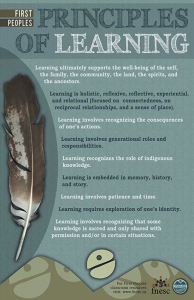My experience with FPPL:
Incorporating components of the First People’s Principles of Learning was a great way to set a goal for a lesson. Embedding this within the learning was a great way to ensure that each lesson has a clear goal aside from the learning intention and that each learner develops different skills aside from the academic portion within the lesson. Not only are these aspects of learning important for effective social-emotional learning, but it also equips the students with skills to overcome everyday adversities and to value skills that may not directly influence assessment. This demonstrates to students how important it is to find value in life’s challenges.
First People’s Principles of Learning show students that a school is a place for personal growth along with academic growth. It demonstrates a safe and inclusive learning community and strengthens their trust within the classroom. It is essential that this is valued throughout learners’ entire school experience as this provides skills that will help them in being effective members of their community.
Each component of FPPL reflects an acknowledgement that is important for each individual to know, even as adults. We need to hold value to these components to ensure that we are living holistically and that we are aware of the impacts of different aspects of our lives.
I have a few posters collected of the FPPL that I plan on placing in my classroom. I value these principles and enjoy the visual to refer to when I am teaching.
A few links to start with or refer to:
First Peoples Principles of Learning – Poster – from FNESC
http://www.fnesc.ca/wp/wp-content/uploads/2015/09/PUB-LFP-POSTER-Principles-of-Learning-First-Peoples-poster-11×17.pdf
First Peoples Principles of Learning – Blog – by Jo Chrona from FNESC
https://firstpeoplesprinciplesoflearning.wordpress.com/
Learning First Peoples Classroom Resources – from FNESC
http://www.fnesc.ca/learningfirstpeoples/
